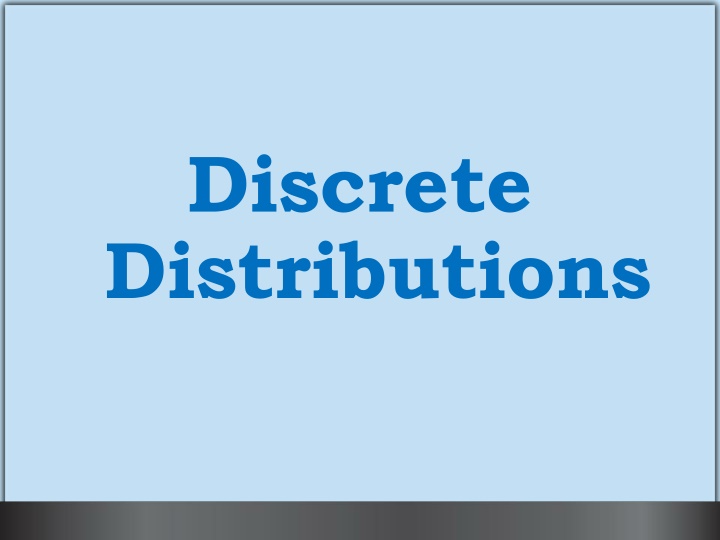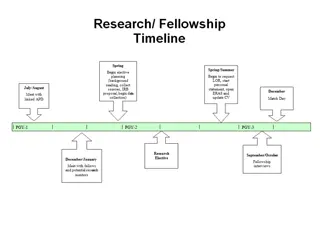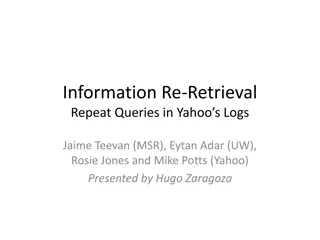Finding the Right Mentor: A Life-Changing Journey
Discover the powerful impact of mentorship through biblical examples like Jethro, David, Barnabas, and Paul. Learn how to recognize those in need of guidance and transform lives through mentoring relationships. Explore the story of Saul's conversion and how Ananias played a crucial role in his journey. Uncover the essence of mentorship in shaping destinies and spreading light in the darkness of uncertainty and doubt.
Download Presentation

Please find below an Image/Link to download the presentation.
The content on the website is provided AS IS for your information and personal use only. It may not be sold, licensed, or shared on other websites without obtaining consent from the author.If you encounter any issues during the download, it is possible that the publisher has removed the file from their server.
You are allowed to download the files provided on this website for personal or commercial use, subject to the condition that they are used lawfully. All files are the property of their respective owners.
The content on the website is provided AS IS for your information and personal use only. It may not be sold, licensed, or shared on other websites without obtaining consent from the author.
E N D
Presentation Transcript
Discrete Distributions 1
Learning Objectives Distinguish between discrete random variables and continuous random variables. Know how to determine the mean and variance of a discrete distribution. Identify the type of statistical experiments that can be described by the binomial distribution, and know how to calculate probabilities based on the binomial distribution. 2
Random Variable A variable which contains the outcomes of a chance experiment Focusing our attention on the numerical features of the elementary outcomes, we introduce the idea of a random variable. A random variable X associates numerical values with each elementary outcome of an experiment. A quantity resulting from an experiment that, by chance, can assume different values. 3
The numerical values are determined by some characteristic of the elementary outcome, and typically it will vary from outcome to outcome. The word random serves to emphasize the fact that before the experiment is performed, we do not know the specific outcome and, consequently, its associated value of X. The following examples illustrate the concept of a random variable. 4
Experiment: Outcome HHH HHT HTH HTT THH THT TTH TTT Value of X 3 2 2 1 2 1 1 0 5
For each elementary outcome, there is only one value for X. However, several elementary outcomes may yield the same value. Scanning our list, we now identify the events (the collections of elementary outcomes) that correspond to distinct values of X. 6
Numerical Value of X as an Event X =0 Composition of the Event = {TTT} X = 1 = {HTT, THT, TTH} X = 2 = {HHT, HTH, THH} X = 3 = {HHH} 7
The random variable X, the number of heads in three tosses of a coin, defines a correspondence between the collections of elementary outcomes and the real numbers 0, 1, 2, and 3. Guided by this example, we have two general facts: The events corresponding to the distinct values of X are incompatible; that is, any two of these events cannot occur together. The union of these events is the entire sample space. 8
Discrete vs. Continuous Distributions Random Variable - a variable which contains the outcomes of a chance experiment Discrete Random Variable A random variable that only takes on distinct values ex: Number of heads on 10 flips, Number of defective items in a random sample of 100, Number of times you check your watch during class, etc. Continuous Random Variable A random variable that takes on infinite values by increasing precision. For each two values, there always exists a valid value in between them. ex: Time until a bulb goes out, height, etc. 9
Describing a Distribution A distribution can be described by constructing a graph of the distribution Measures of central tendency and variability can be applied to distributions 10
Describing a Discrete Distribution Mean of discrete distribution is the long run average If the process is repeated long enough, the average of the outcomes will approach the long run average (mean) Mean of a discrete distribution = (Xi * P(Xi)) where is the long run average, Xi = the ith outcome 11
Describing a Discrete Distribution Variance of a discrete distribution is obtained in a manner similar to raw data, summing the squared deviations from the mean and weighting them by P(Xi) (rather than dividing by n): Var(Xi) = ((Xi )2* P(Xi)) Standard Deviation is computed by taking the square root of the variance 12
Discrete Distribution -- Example An executive is considering out-of-town business travel for a given Friday. At least one crisis could occur on the day that the executive is gone. The distribution on the following slide contains the number of crises that could occur during the day the executive is gone and the probability that each number will occur. For example, there is a .37 probability that no crisis will occur, a .31 probability of one crisis, and so on. 13
Discrete Distribution -- Example Distribution of Daily Crises 0.5 P r o b a b i l i t y Number of Crises Probability 0.4 0.3 0 1 2 3 4 5 0.37 0.31 0.18 0.09 0.04 0.01 0.2 0.1 0 0 1 2 3 4 5 Number of Crises 14
Mean and Standard Deviation of a Discrete Distribution X- -1.15 -0.15 0.85 1.85 2.85 3.85 8.1 (X- ) (X- ) P 1.32 0.02 0.72 3.42 8.12 14.82 28.44 # Crises (X) Prob (P) 0 1 2 3 4 5 SUM: XP 0 0.31 0.36 0.27 0.16 0.05 1.15 0.37 0.31 0.18 0.09 0.04 0.01 1 0.49 0.01 0.13 0.31 0.32 0.15 1.41 = = . 1 15 XP ( ) ( ) X 2 = = = = 2 . 1 41 . 1 19 X P 15
Requirements for a Discrete Probability Function -- Examples - Each probability must be between 0 and 1 - The sum of all probabilities must be equal to 1. X P(X) X P(X) X P(X) -1 0 1 2 3 -.1 .3 .4 .3 .1 1.0 -1 0 1 2 3 .1 .2 .4 .2 .1 1.0 -1 0 1 2 3 .1 .3 .4 .3 .1 1.2 NOT VALID NOT VALID VALID 16
Binomial Distribution The binomial distribution is a discrete distribution where X is the number of successes and the following four conditions are met: There are n trials The n trials are independent of each other The outcome is dichotomous only two outcomes possible The probability of success is constant Example, 10 coin flips, X = # of heads X = the number of successes and we say X follows a Binomial distribution with n trial and P(success) = p If the data follow a binomial distribution, then we can summarize P(Xi) for all values of Xi= 1, , n through the binomial probability distribution formula 17
Binomial Distribution ! n pX n X = ( ) P X q Probability function ( 0 p ) ! ! X n X = for n , q 1 p X n = Mean value Variance and Standard Deviation 2 = n p q 2 = = n p q 18
Binomial Distribution: Development Experiment: randomly select, with replacement, two families from the residents of Tiny Town Success is Children in Household: p = 0.75 Failure is No Children in Household: q = 1- p = 0.25 X is the number of families in the sample with Children in Household Children in Household Number of Automobiles Listing of Sample Space Family (A,B), (A,C), (A,D), (A,A), (B,A), (B,B), (B,C), (B,D), (C,A), (C,B), (C,C), (C,D), (D,A), (D,B), (D,C), (D,D) A B C D Yes Yes No Yes 3 2 1 2 19
Binomial Distribution: Development Continued Listing of Sample Space Families A, B, and D have children in the household; family C does not Success is Children in Household: p = 0.75 Failure is No Children in Household: q = 1- p = 0.25 X is the number of families in the sample with Children in Household P(outcome) X (A,B), (A,C), (A,D), (A,A) (B,A), (B,B), (B,C), (B,D), (C,A), (C,B), (C,C), (C,D), (D,A), (D,B), (D,C), (D,D) 1/16 1/16 1/16 1/16 1/16 1/16 1/16 1/16 1/16 1/16 1/16 1/16 1/16 1/16 1/16 1/16 2 1 2 2 2 2 1 2 1 1 0 1 2 2 1 2 20
Binomial Distribution: Development Continued Families A, B, and D have children in the household; family C does not Success is Children in Household: p = 0.75 Failure is No Children in Household: q = 1- p = 0.25 X is the number of families in the sample with Children in Household Possible Sequences P(sequence) X ) (. ) = = 25 2 (F,F) 0 (. 25 25 )(. (S,F) 1 (. )(. ) 75 25 (F,S) 1 (. )(. ) 25 75 (. )(. ) (. ) 75 75 75 2 = = (S,S) 2 21
Binomial Distribution: Development Continued Possible Possible Possible Sequences Sequences Sequences P(sequence) P(sequence) P(sequence) P(X) P(X) P(X) X X X X X X ) (. ) 25 25 ) (. ) = = ) (. ) = = 25 = = (. )(. ) 25 75 ) (. ) ) (. ) = = 25 = = 25 = = ) (. ) 25 2 2 2 2 2 2 (F,F) (F,F) (F,F) 0 0 0 0 0 0 (. (. (. 25 25 25 25 25 25 )(. )(. )(. =0.0625 =0.0625 =0.0625 (. (. (. 25 25 25 25 25 25 )(. )(. )(. =0.375 =0.375 =0.375 (. )(. ) 25 75 75 = = 75 = = 75 = = (. )(. ) 25 75 2 2 2 (S,F) (S,F) (S,F) 1 1 1 1 1 1 (. )(. ) 75 25 (. )(. ) 75 25 (. )(. ) 75 25 )(. ) (. ) )(. ) (. ) 75 75 75 75 75 75 )(. ) (. ) 2 2 2 (. (. (. (F,S) (F,S) (F,S) 1 1 1 2 2 2 =0.5625 =0.5625 =0.5625 (. )(. ) 25 75 (. )(. ) (. ) (. )(. ) 25 75 (. )(. ) (. ) (. )(. ) 25 75 )(. ) (. ) 75 75 75 75 = = 75 75 = = 75 75 75 2 2 2 = = (S,S) (S,S) (S,S) 2 2 2 (. ! ! n n n ! n x n x n x p q p q p q x x x = = = P X ( P X ( P X ( ) ) ) ( ( ( ) ) ) X n ! X n ! X n ! ! ! ! X X X 2 2 2 ! ! 2 2 2 ! ! ! ! . . . 75 25 75 25 75 25 . . . . . . 75 25 75 25 75 25 . . . 1 1 1 2 1 2 1 2 1 0 0 0 2 0 2 0 2 0 = = = = = = = = = = = = = = = = = = P X ( P X ( P X ( 1 1 1 ) ) ) 0375 0375 0375 . . . P X ( P X ( P X ( 0 0 0 ) ) ) 00625 00625 00625 . . . ( ( ( ) ) ) ( ( ( ) ) ) 1 2 1 1 2 1 1 2 1 ! ! ! ! ! ! 0! 2 0! 2 0! 2 0 0 0 ! ! ! 2 2 2 ! ! ! . . . 75 25 75 25 75 25 . . . 2 2 2 2 2 2 2 2 2 = = = = = = = = = P X ( P X ( P X ( 2 2 2 ) ) ) 05625 05625 05625 . . . ( ( ( ) ) ) 2 2 2 2 2 2 ! ! ! 2 2 2 ! ! ! 22
Binomial Distribution: Demonstration Problem According approximately 6% of all workers in Jackson, Mississippi, are unemployed. In conducting a random telephone survey in Jackson, what is the probability of getting two or fewer unemployed workers in a sample of 20? to the U.S. Census Bureau, 23
Binomial Distribution: Demonstration Problem In this example, 6% are unemployed => p The sample size is 20 => n 94% are employed => q X is the number of successes desired What is the probability of getting 2 or fewer unemployed workers in the sample of 20? => P(X 2) The hard part of this problem is identifying p, n, and x emphasize this when studying the problems. 24
Binomial Distribution: Demonstration Problem = 20 n = 06 . p = 94 . q = = + = + = ( ) 2 ( ) 0 ( ) 1 ( ) 2 P X P X P X P X = + + = 2901 . 3703 . 2246 . 8850 . 20 ! 0 20 0 ( ) ( ) = = = = ( ) 0 06 . 94 . 2901 )(. 1 )( 1 ( ) 2901 . P X ( ! 0 20 0 )! 20 ! 1 20 1 ( ) ( ) = = = = ( ) 1 . 06 94 . ( 3086 )(. 06 )(. 20 ) 3703 . P X ( ! 1 20 1 )! 20 ! 2 20 2 ( ) ( ) = = = = ( ) 2 06 . 94 . 190 ( 0036 )(. 3283 )(. ) 2246 . P X ( ! 2 20 2 )! 25
Binomial Distribution: Demonstration Problem What are the mean and standard deviation of this distribution? )(. 20 ( = = p n = 06 ) . 1 20 2 = = = ( 20 )(. 06 )(. 94 ) . 1 128 n p q 2 = = = . 1 128 . 1 062 26
Example: Solve the binomial probability for n=20, p=.40, and x=10 by using Binomial Probability Distribution. 27
Using the Binomial Table Solution: n = 20 PROBABILITY 0.2 X 0.1 0.3 0.4 0 1 2 3 4 5 6 7 8 9 0.122 0.270 0.285 0.190 0.090 0.032 0.009 0.002 0.000 0.000 0.000 0.000 0.000 0.000 0.000 0.000 0.000 0.000 0.000 0.000 0.000 0.012 0.058 0.137 0.205 0.218 0.175 0.109 0.055 0.022 0.007 0.002 0.000 0.000 0.000 0.000 0.000 0.000 0.000 0.000 0.000 0.000 0.001 0.007 0.028 0.072 0.130 0.179 0.192 0.164 0.114 0.065 0.031 0.012 0.004 0.001 0.000 0.000 0.000 0.000 0.000 0.000 0.000 0.000 0.000 0.003 0.012 0.035 0.075 0.124 0.166 0.180 0.160 0.117 0.071 0.035 0.015 0.005 0.001 0.000 0.000 0.000 0.000 0.000 = = 20 40 . n p 10 11 12 13 14 15 16 17 18 19 20 ( ) ( ) 10 10 40 . 60 . = = = P X ( 10 ) 01171 . C 20 10 28
Binomial Distribution using Table: U.S. Census Bureau Problem = = = = n p q 20 06 94 2 2901 . n = 20 PROBABILITY X 0.05 0 0.3585 0.2901 0.2342 1 0.3774 0.3703 0.3526 2 0.1887 0.2246 0.2521 3 0.0596 0.0860 0.1139 4 0.0133 0.0233 0.0364 5 0.0022 0.0048 0.0088 6 0.0003 0.0008 0.0017 7 0.0000 0.0001 0.0002 8 0.0000 0.0000 0.0000 20 0.0000 0.0000 0.0000 . . 0.06 0.07 = = + . = . = 1 8850 ) 06 + = P X ( ) P X + . = 1 ( 0 P X 2246 2 )(. 20 ) ( 1 8850 ) P X ( 2 ) + = 3703 = . P X ( = 2 ) P X ( = ) . . 1150 = n p ( 1 20 2 = n p q = = ( 20 )(. 06 )(. 94 ) 1128 . 2 = = = 1128 . 1 062 . 29
Binomial Distribution Table: Demonstration Problem = = = = n p q 20 06 94 2 2901 . n = 20 PROBABILITY X 0.05 0 0.3585 0.2901 0.2342 1 0.3774 0.3703 0.3526 2 0.1887 0.2246 0.2521 3 0.0596 0.0860 0.1139 4 0.0133 0.0233 0.0364 5 0.0022 0.0048 0.0088 6 0.0003 0.0008 0.0017 7 0.0000 0.0001 0.0002 8 0.0000 0.0000 0.0000 20 0.0000 0.0000 0.0000 . . 0.06 0.07 = = + . = . + = P X ( ) P X + . ( 0 ) P X 2246 ( 1 8850 ) P X ( 2 ) + = 3703 30
Excels Binomial Function n = 20 p = 0.06 X P(X) 0 =BINOMDIST(A5,B$1,B$2,FALSE) 1 =BINOMDIST(A6,B$1,B$2,FALSE) 2 =BINOMDIST(A7,B$1,B$2,FALSE) 3 =BINOMDIST(A8,B$1,B$2,FALSE) 4 =BINOMDIST(A9,B$1,B$2,FALSE) 5 =BINOMDIST(A10,B$1,B$2,FALSE) 6 =BINOMDIST(A11,B$1,B$2,FALSE) 7 =BINOMDIST(A12,B$1,B$2,FALSE) 8 =BINOMDIST(A13,B$1,B$2,FALSE) 9 =BINOMDIST(A14,B$1,B$2,FALSE) 31
Graphs of Selected Binomial Distributions n = 4 PROBABILITY X 0 0.656 1 0.292 2 0.049 3 0.004 4 0.000 P = 0.5 1.000 0.1 0.5 0.9 0.900 0.800 0.063 0.250 0.375 0.250 0.063 0.000 0.004 0.049 0.292 0.656 0.700 0.600 0.500 P(X) 0.400 0.300 0.200 0.100 0.000 0 1 2 3 4 X P = 0.1 P = 0.9 1.000 1.000 0.900 0.900 0.800 0.800 0.700 0.700 0.600 0.600 0.500 0.500 P(X) P(X) 0.400 0.400 0.300 0.300 0.200 0.200 0.100 0.100 0.000 0.000 0 1 2 3 4 0 1 2 3 4 X X 32
Example: Purchasing magazine reported the result of a survey in which buyers were asked a series of questions with regard to Internet usages. One question asked was how they would use the Internet if security and other issue could be resolved. 78% said they would use it for pricing information, 75% said they would use it to send purchase orders, and 70% said they would use it for purchase order acknowledgements. Assume that these percentages hold true for all buyers. A researcher randomly samples 20 buyers and asks them how they would use the Internet if security and other issues could be resolved. 33
Questions: What is the probability that exactly 14 of these buyers would use the Internet for pricing information? What is the probability that all of the buyers would-use the Internet to send purchase orders? What is probability that fewer than 12 would use the Internet for purchase order acknowledgements? 34
Solution: a) n = 20 p = .78 x = 14 20C14 (.78)14(.22)6 = 38,760(.030855)(.00011338) = .1356 b) n = 20 p = .75 x = 20 20C20 (.75)20(.25)0 = (1)(.0031712)(1) = .0032 c) n = 20 P(x=0) + P(x=1) + . . . + P(x=11) = 0.000 + 0.000 + 0.000 + 0.000 + 0.000 + 0.000 + 0.000 + 0.001 + 0.004 + 0.012 +0 .031 + 0.065 = .113 p = .70 x < 12 Use table : 35
Example: The Wall Street Journal reported some interesting statistics on the job market. One statistic is that 40% of all workers say they would change jobs for slightly higher pay . In addition, 88% of companies say that there is a shortage of qualified job candidates. Suppose 16 workers are randomly selected and asked if they would change jobs for slightly higher pay . What is the probability that nine or more say yes? What is the probability that three, four, five, or six say yes? If 13 companies are contacted, what is the probability that exactly 10 say there is a shortage of qualified job candidates? What is the probability that all of the companies say there is a shortage of qualified job candidates? What is the expected number of companies that would say there is a shortage of qualified job candidates? 36
Solution: n = 16 p = .40 P(x > 9): from Table x Prob .084 .039 .014 .004 .001 .142 9 10 11 12 13 37
Solution: p(3 < x < 6): n = 13 p = .88 x 3 4 5 6 Prob .047 .101 .162 .198 .508 P(x = 10) = 13C10(.88)10(.12)3 = 286(.278500976)(.001728) = .1376 P(x = 13) = 13C13(.88)13(.12)0 = (1)(.1897906171)(1) = .1898 Expected Value = = n p = 13(.88) = 11.44 38
Question 5.22 Harley Davidson, director of quality control for the Kyoto motor company is conducting his monthly spot check of automatic transmissions. In this procedure, 10 transmissions are removed from the pool of components and are checked for manufacturing defects. Historically, only transmissions have such flows. (Assume that flaws occur independently in different transmissions.) 2 percent of the (a) What is the probability that Harley s sample contains more than two manufacturing flaws? (Do not use the transmissions with tables.) (b) What is the probability that none of the selected transmissions has any manufacturing flaws? (Do not use the tables.) 39
Solution: P (more than 2 flaws) = 1 P(0 flaws) P(1 flaw) P(2 flaws) = 1 (0.02)0 (0.98)10 (0.02)1(0.98)9 = 1 0.8171 0.1667 0.0153 = 0.0009 (0.02)2(0.98)8 P (0 flaws) = (.02)0 (.98)10 = 0.8171 40
Question 5.23 Diane Burns is the mayor of a large city. Lately, she has become concerned about the possibility that large numbers of people who are drawing unemployment checks are secretly employed. Her assistants estimate that 40 percent of unemployment beneficiaries fall into this category, but Ms. Bruns is not convinced. She asks one of her aides to conduct a quite investigation of 10 randomly selected unemployment beneficiaries. (a) If the mayer s assistants are correct, what is the probability that more than eight of individuals investigated have jobs? (b) If the mayor s assistants are correct, what is the probability that only three of the investigated have jobs? 41
Solution: a) P (more than 8 have jobs) b) P (3 have jobs) = P(r = 9) + P(r = 10) = (.40)9 (.60)1 + (.40)10 (.60)0 = .0016 + .0001 = .0017. = (.40)3(.60)7 =.2150. 42
Poisson Distribution The Poisson distribution focuses only on the number of discrete occurrences over some interval or continuum Poisson does not have a given number of trials (n) as a binomial experiment does Occurrences are independent of other occurrences Occurrences occur over an interval 43
Poisson Distribution If Poisson distribution is studied over a long period of time, a long run average can be determined The average is denoted by lambda ( ) Each Poisson distribution contains a lambda value from which the probabilities are determined A Poisson distribution can be described by alone 44
Poisson Distribution Describes discrete occurrences over a continuum or interval A discrete distribution Describes rare events Each occurrence is independent any other occurrences. The number of occurrences in each interval can vary from zero to infinity. The expected number of occurrences must hold constant throughout the experiment. 45
Poisson Distribution: Applications Arrivals at queuing systems airports -- people, airplanes, automobiles, baggage banks -- people, automobiles, loan applications computer file servers -- read and write operations Defects in manufactured goods number of defects per 1,000 feet of extruded copper wire number of blemishes per square foot of painted surface number of errors per typed page 46
Poisson Distribution Probability function X e = = for ( ) 3 , 2 , 1 , 0 ,... P X X ! X : where = longrun average = (the ... base of natural logarithms ) 718282 . 2 e Mean value Variance Standard deviation 47
Poisson Distribution: Demonstration Problem Bank customers arrive randomly on weekday afternoons at an average of 3.2 customers every 4 minutes. What is the probability of having more than 7 customers in a 4-minute interval on a weekday afternoon? A bank has an average random arrival rate of 3.2 customers every 4 minutes. What is the probability of getting exactly 10 customers during on 8-minute interval? 48
Poisson Distribution: Demonstration Problem - Solution = 3.2 customers/4 minutes We want to calculate P(X > 7 customers/4 minutes) The problem can either be solved as: P(X>7) = P(X=8) + P(X=9) + , or P(X>7) = 1 P(X 7) = 1 [P(X=7) + P(X=6) + + P(X=0)] The answer can be obtained directly or through software The answer you get is 1.7% of the time. Bank officers could use these results to help them make staffing decisions. 49
Solution: = customers/ 2 . 3 minutes 4 customers/ 7 = X minutes 4 X e P(X) = ! 3.2 X 2 . 3 2 . 3 2 . 3 8 9 10 3.2 3.2 e e e + + = ( ) 7 = 016333 . 0 P X ! 8 ! 9 10 ! 50























